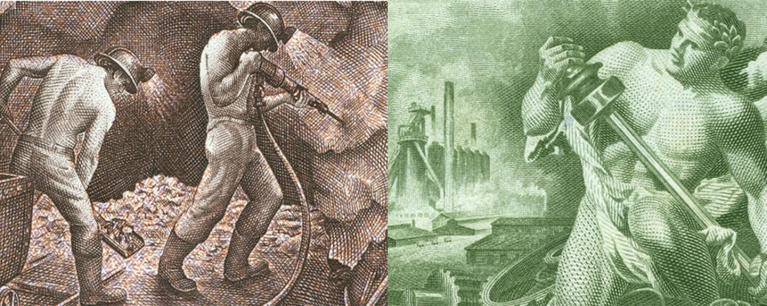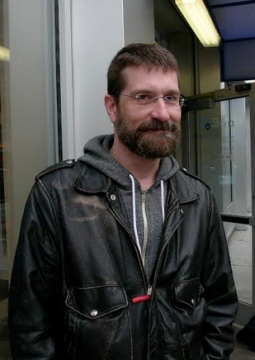
Frames from the 2014 film “Model Workers” by William E. Jones on display in the Wexner Center’s The Box. Credit: Courtesy of Jennifer Lange
Ohio-born, Los Angeles-based artist William E. Jones presents paper currency from all around the world. His film, titled “Model Workers,” brings color and perspective to currency.
The film focuses on currency art that depicts human labor, Jones said in an email, adding that the bills tended to come from poorer and socialist countries.
“These countries may be proud of their traditional agriculture or of industrial development, but what they have in common is the decision to honor not ‘great men’ but working people on their money,” Jones said.
Jones began his relationship with the Wexner Center in 1991. Since then, he has made numerous visits to the Wex to work in its film/video studio. Jennifer Lange, curator of the film/video studio program, chose “Model Workers” to screen because she thought it would be fun to show his most recent work.
“In a lot of his work, he used found footage, going through archives, and researching archives and pulling footage that interests him, whether it’s Korean military training videos or 1960s commercials. He has an endless fascination with archival imagery, moving and still,” Lange said.
Jones collected the currency over a span of two years in order to make “Model Workers” and it is shown chronologically. Jones said that one challenge in making “Model Workers” was that some of the currency was quite expensive.
One of the finds of his search was that rich Western countries tended to not depict labor — “the source of their wealth,” Jones said.
“I noticed that there is a direct relation between a country’s political and economic power and the likelihood that this country would not represent workers on its money,” he said.

Credit: Courtesy of William Jones
“Model Workers” will be shown at the Wexner Center for the Arts’ free exhibition space called The Box, a small room that features videos from various artists and plays them on repeat.
“Many works are short films. They can be anywhere from a narrative film, fiction, documentary, or an experimental film, we’ve had every type of genre style that you can think of,” said Wexner Center spokesman Erik Pepple. “It is really a great experience for those who are interested in film and visual arts to come check out the latest and most cutting-edge films in the independent film world.”
A video is usually picked to run for the entire month at The Box. Often times, these videos are done by artists who have worked at the Wexner Center, exhibited their work before or who have previously screened at the Wexner Center, Pepple said.
“There’s really no installation time necessary, no down time, so a show opens on the 1st and closes on the 30th or 31st,” Lange said. “It’s a super active space.”
The Wexner’s Film/Video Program is a residency program which allows artists to come and use its equipment, studio and editors, Lange said. Jones’ work has been exhibited several times at the Wexner Center and he has made close to 40 videos through the studio program, Lange said.
“His previous work focused a lot on the labor and capital of the porn industry,” she said. “There’s a certain homoeroticism about ‘Model Workers.’”
Jones has related work which is now being shown at the Columbus Museum of Art, in his exhibition called “In___We Trust: Art and Money.”
“Model Workers” will be shown on The Box’s screen starting this Sunday until Feb. 28. Admission is free.


